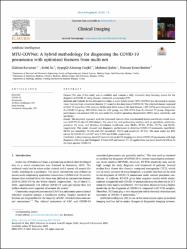| dc.contributor.author | Kavuran, Gürkan | |
| dc.contributor.author | İn, Erdal | |
| dc.contributor.author | Altıntop Geçkil, Ayşegül | |
| dc.contributor.author | Şahin, Mahmut | |
| dc.contributor.author | Kırıcı Berber, Nurcan | |
| dc.date.accessioned | 2021-10-18T06:18:20Z | |
| dc.date.available | 2021-10-18T06:18:20Z | |
| dc.date.issued | 2022 | en_US |
| dc.identifier.citation | Kavuran, G., İn, E., Geçkil, A. A., Şahin, M., & Berber, N. K. (2022). MTU-COVNet: A hybrid methodology for diagnosing the COVID-19 pneumonia with optimized features from multi-net. Clinical Imaging, 81, 1-8. | en_US |
| dc.identifier.issn | 0899-7071 | |
| dc.identifier.uri | https://doi.org/10.1016/j.clinimag.2021.09.007 | |
| dc.identifier.uri | 1873-4499 | |
| dc.identifier.uri | https://hdl.handle.net/20.500.12899/452 | |
| dc.description.abstract | COVID-19PneumoniaArtificial intelligence (AI)Deep learningComputed tomography (CT) | en_US |
| dc.description.abstract | Purpose: The aim of this study was to establish and evaluate a fully automatic deep learning system for the diagnosis of COVID-19 using thoracic computed tomography (CT). Materials and methods: In this retrospective study, a novel hybrid model (MTU-COVNet) was developed to extract visual features from volumetric thoracic CT scans for the detection of COVID-19. The collected dataset consisted of 3210 CT scans from 953 patients. Of the total 3210 scans in the final dataset, 1327 (41%) were obtained from the COVID-19 group, 929 (29%) from the CAP group, and 954 (30%) from the Normal CT group. Diagnostic performance was assessed with the area under the receiver operating characteristic (ROC) curve, sensitivity, and specificity. Results: The proposed approach with the optimized features from concatenated layers reached an overall accuracy of 97.7% for the CT-MTU dataset. The rest of the total performance metrics, such as; specificity, sensitivity, precision, F1 score, and Matthew Correlation Coefficient were 98.8%, 97.6%, 97.8%, 97.7%, and 96.5%, respectively. This model showed high diagnostic performance in detecting COVID-19 pneumonia (specificity: 98.0% and sensitivity: 98.2%) and CAP (specificity: 99.1% and sensitivity: 97.1%). The areas under the ROC curves for COVID-19 and CAP were 0.997 and 0.996, respectively. Conclusion: A deep learning–based AI system built on the CT imaging can detect COVID-19 pneumonia with high diagnostic efficiency and distinguish it from CAP and normal CT. AI applications can have beneficial effects in the fight against COVID-19. | en_US |
| dc.language.iso | en | en_US |
| dc.publisher | Elsevier | en_US |
| dc.relation.ispartof | Clinical Imaging | en_US |
| dc.rights | info:eu-repo/semantics/openAccess | en_US |
| dc.subject | COVID-19 | en_US |
| dc.subject | Pneumonia | en_US |
| dc.subject | Artificial intelligence (AI) | en_US |
| dc.subject | Deep learning | en_US |
| dc.subject | Computed tomography (CT) | en_US |
| dc.title | MTU-COVNet: A hybrid methodology for diagnosing the COVID-19 pneumonia with optimized features from multi-net | en_US |
| dc.type | Article | en_US |
| dc.authorid | 0000-0003-2651-5005 | en_US |
| dc.authorid | 0000-0002-8807-5853 | en_US |
| dc.authorid | 0000-0003-0348-3194 | en_US |
| dc.authorid | 0000-0003-0348-3194 | |
| dc.department | MTÖ Üniversitesi, Mühendislik ve Doğa Bilimleri Fakültesi, Elektrik-Elektronik Mühendisliği Bölümü | en_US |
| dc.department | MTÖ Üniversitesi, Tıp Fakültesi, Dahili Tıp Bilimleri Bölümü | en_US |
| dc.institutionauthor | Kavuran, Gürkan | |
| dc.institutionauthor | İn, Erdal | |
| dc.institutionauthor | Altıntop Geçkil, Ayşegül | |
| dc.institutionauthor | Kırıcı Berber, Nurcan | |
| dc.identifier.doi | 10.1016/j.clinimag.2021.09.007 | |
| dc.identifier.volume | 81 | en_US |
| dc.identifier.startpage | 1 | en_US |
| dc.identifier.endpage | 8 | en_US |
| dc.relation.publicationcategory | Makale - Uluslararası Hakemli Dergi - Kurum Öğretim Elemanı | en_US |


















